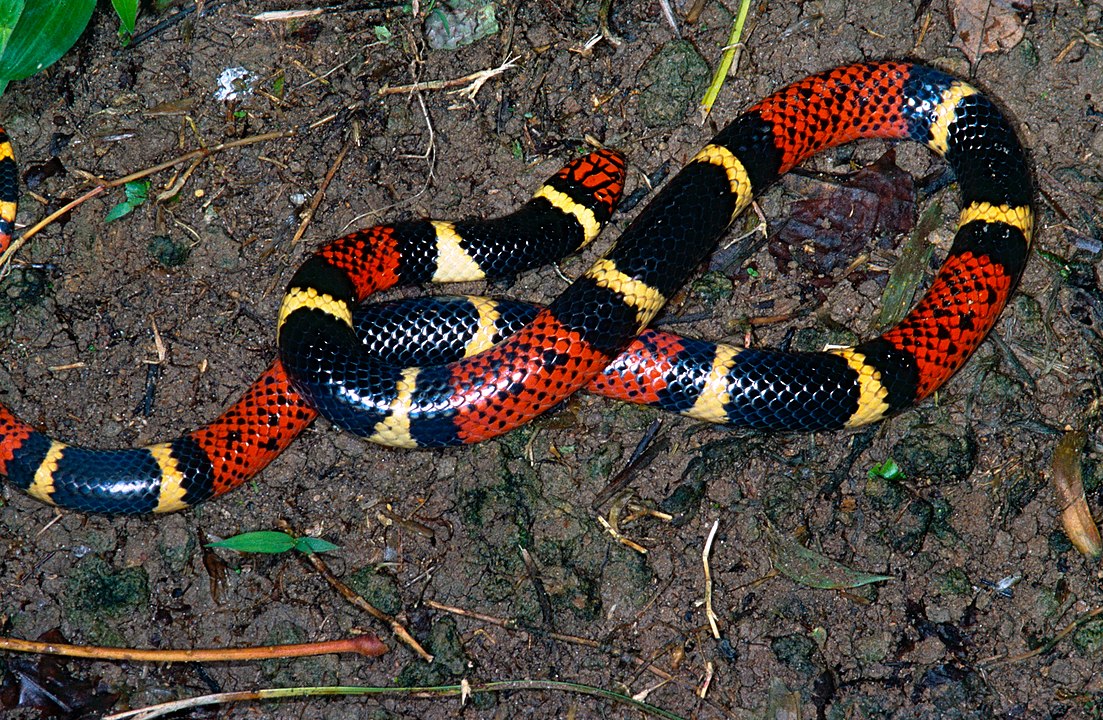Coral snakes are a large group of elapid snakes that can be subdivided into two distinct groups, Old World coral snakes and New World coral snakes. There are 16 species of Old World coral snake in three genera (Calliophis, Hemibungarus, and Sinomicrurus), and over 65 recognized species of New World coral snakes in three genera (Leptomicrurus, Micruroides, and Micrurus). Genetic studies have found that the most basal lineages are Asian, indicating that the group originated in the Old World. Three species of coral snakes found in Guyana are 1/ Micrurus lemniscatus, commonly known as the South American coral snake and 2/ Micrurus surinamensis, commonly known as the aquatic coral snake and 3/ Leptomicrurus collaris, commonly known as Guyana blackback coral snake.
Scientific Classification Of The Coral Snakes
- Kingdom: Animalia
- Phylum: Chordata
- Class: Reptilia
- Order: Squamata
- Suborder: Serpentes
- Superfamily: Elapoidea
- Family: Elapidae
- Genera (Old World): Calliophis, Hemibungarus and Sinomicrusus
- Genera (New World): Leptomicrurus, Micruroides and Micrusus
Features Of The Coral Snakes
- Rhyme – “Red on yellow kills a fellow. Red on black, venom lack.” or “Red touches black, it’s a friend of Jack. Red touches yellow, it’s bad for a fellow.” or “Red touches yellow, you’re a dead fellow. Red touches black, you’re okay Jack.” It is noteworthy that this rhyme only applies to the North American coral snake but here in the tropics a bite from either snake may be fatal.
- Color – Coral snakes in North America are most notable for their red, yellow/white, and black colored banding. However, coral snakes found in other parts of the world can have distinctly different patterns, have red bands touching black bands, have pink, blue, white, and black banding, or have no banding at all. Both the Micrusus surinamensis and the Micrurus lemniscatus are red, black and yellow in color.
- Size – Most species of coral snake are small in size. North American species average around 3 feet (91 cm) in length, but specimens of up to 5 feet (150 cm) or slightly larger have been reported. Aquatic species have flattened tails acting as a fin, aiding in swimming.
Habitat Of The Coral Snakes
They can be found in pine and scrub oak sandhill habitats in parts of this range but sometimes inhabit hardwood areas and pine flatwoods that undergo seasonal flooding. It occupies arid and semiarid regions in many different habitat types including thornscrub, desert-scrub, woodland, grassland and farmland. It is found in the plains and lower mountain slopes from sea level to 5800 feet (1768 m); often found in rocky areas. In Guyana, they can be found in bushy/forested areas as well as in the Iwokrama Rainforest.
Diet & Reproduction Of The Coral Snakes
Coral snakes eat lizards, frogs, nestling birds, small rodents and other small, smoothed-scaled snakes. National Geographic reported that Eastern coral snakes will eat frogs, and Western coral snakes are particularly fond of devouring blind or black-headed snakes, according to the Arizona-Sonora Desert Museum.
Unlike many other venomous snakes that give birth to live young, coral snakes lay eggs. Eastern coral snakes lay six or seven eggs in the summer that hatch in early fall. Western coral snakes lay two to three eggs. Babies are born brightly colored, fully venomous, and 7 inches (17 cm) long. Baby snakes emerge from their eggs 7 inches long and fully venomous. Adults reach about 2 feet in length. Average lifespan in the wild is unknown, but they can live up to seven years in captivity.
Five Facts About The Coral Snakes
- Species like the Micrurus surinamensis (Aquatic coral snake), are almost entirely aquatic and spend most of their lives in slow-moving bodies of water that have dense vegetation.
- Like all elapid snakes, coral snakes possess a pair of small hollow fangs to deliver their venom. The fangs are positioned at the front of the mouth.
- The fangs are fixed in position rather than retractable, and rather than being directly connected to the venom duct, they have a small groove through which the venom enters the base of the fangs.
- Because the fangs are relatively small and inefficient for venom delivery, rather than biting quickly and letting go (like vipers), coral snakes tend to hold onto their prey and make chewing motions when biting. The venom takes time to take full effect.
- Coral snakes are not aggressive or prone to biting.
Coral Snakes In Guyana
Wildlife handler and exporter, Mr Kurt Herzog, said: “The coral snake can be found in water, as well as on land. Sometimes when going on the highway you see them crawling across the road. It can even be found in swampy places, possibly in yards…Once it is the red, white and black coral it is the real thing. There are plenty different coral snakes in Guyana, but this is the most common one and it is venomous.” He went on to say that coral snakes do not look for people to bite them, instead, they try to avoid them.
Yes, when confronted by humans, coral snakes will almost always attempt to flee, and bite only as a last resort. In addition, coral snakes have short fangs (proteroglyph dentition) that cannot penetrate thick leather clothing. Any skin penetration, however, is a medical emergency that requires immediate attention. Coral snakes have a powerful neurotoxin that paralyzes the breathing muscles; mechanical or artificial respiration, along with large doses of antivenom, are often required to save a victim’s life. There is usually only mild pain associated with a bite, but respiratory failure can occur within hours.
Article References:
- https://en.wikipedia.org/wiki/Coral_snake
- https://en.wikipedia.org/wiki/Micrurus_surinamensis
- https://en.wikipedia.org/wiki/Micrurus_lemniscatus
- http://guyanachronicle.com/2017/06/25/snake-snake
- https://www.stabroeknews.com/2011/07/24/features/coral-snakes/
- https://www.livescience.com/43938-coral-snakes-colors-bites-farts-facts.html
- https://www.nationalgeographic.com/animals/reptiles/e/eastern-coral-snake/
- Main Image: Por Bernard DUPONT from FRANCE – Aquatic Coral Snake (Micrurus surinamensis), CC BY-SA 2.0, https://commons.wikimedia.org/w/index.php?curid=40775143
Discover more from Things Guyana
Subscribe to get the latest posts sent to your email.








1 Comment